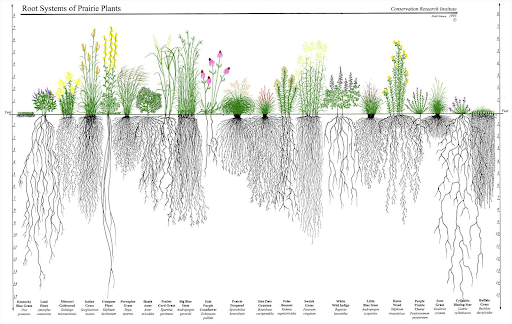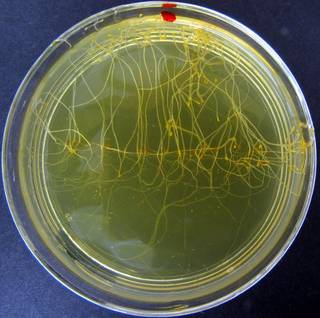Summary
Carrots, sweet potatoes, oak trees—these plants’ root systems come in many different shapes and sizes. Root architecture, or the shape of the root system, depends on many factors: soil texture, water availability, genetics, and more. To grow plants in space, we need to understand and consider the important role of root shape.

Just as plants have different leaves, branching patterns, and canopy shapes, they also have diverse root architectures. As you can see above, some plants (like carrots and pine trees) have a single large taproot, with some smaller, thinner roots branching off the taproot. But most plants have a fibrous root system, where there are numerous thin roots with no single “main” root. As you can see in the picture below, fibrous root systems have many forms—they can be dense with many hundreds of branches, or stringy with only occasional branching. Root systems can be shallow, or they can reach deep down into the soil. They can be narrow and slim, or they can branch widely outward on all sides. This diversity is very useful for plants in their native environments on Earth, but it can cause complications for space farming.

In space agriculture, we grow plants in enclosed containers, so we have to consider all aspects of the system, including the root zone. NASA researchers have been studying roots for years, for instance, they tested different sizes of clay particles they used inside their “plant pillows” (pictured below). They found that small clay particles (<1 mm) were the best for growing leafy greens like lettuce. These “plant pillows” also were designed to be the right size to hold the roots of these leafy greens. But if we tried to grow pepper plants in the same “plant pillows”, it might not work very well since peppers have a more extensive root system with thicker roots. Things get even more complicated as we look toward a future with more diverse plants and more sophisticated hydroponic systems. Lettuce roots are thinner, more delicate, and shorter than pepper roots so they might have a different ideal particle size. Hydroponic systems undergoing testing with lettuce (such as the PONDS system) might not be very effective for plants with thicker, longer roots.

It’s important to also remember that roots grow a bit differently in space. For example, roots on young seedlings tend to “skew” in a slanted direction instead of growing straight “down”. Since there is no “up” or “down” in microgravity, we must give the plants different cues to grow their roots in the direction we want them to. We can do this by angling seeds in the right direction, so the “root” end of the seed is facing away from the lights. We’ve also found that the colors of light affect root growth, where (in microgravity) roots will grow away from blue light and/or toward red light. We’ve learned a lot about roots in space, but there are still many topics we haven’t explored.
Some unexplored questions include:
- Does space-grown lettuce have a different root architecture than lettuce on Earth?
- Can space-grown plants cope with root-zone compaction better than Earth-grown plants?
- How can we leverage natural root architecture to design more sophisticated hydroponic systems for spaceflight?
The more questions we explore, and the more we learn about roots in space, the better we’ll be able to prepare astronauts to travel to Mars and beyond.
References:
- Root System Architecture and Abiotic Stress Tolerance: Current Knowledge in Root and Tuber Crops
- Root Systems by Dr. James Estrada, University of Florida. Notes from Crop Plant Physiology (Lecture 21), class code AGR4512
- Crop and Substrate Tests with Single Use Rooting” Pillows” for the VEGGIE Plant Growth Hardware
- From Kennedy, to Beyond: Growing Plants in Space
- Root Phototropism: How Light And Gravity Interact In Shaping Plant Form

